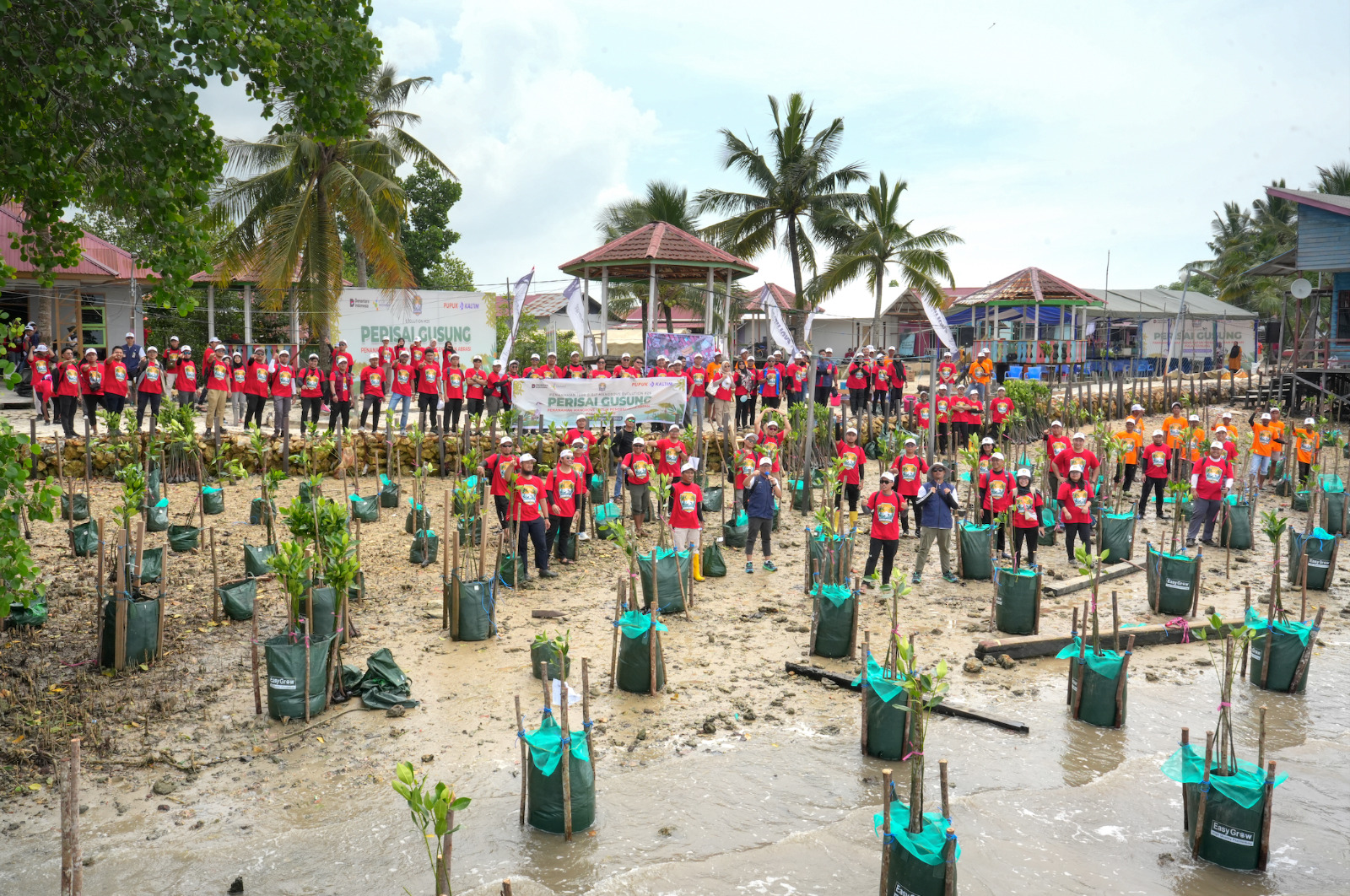Stakeholder Engagement
Pupuk Kaltim recognizes that the success of sustainability strategies cannot be separated from the active participation of all stakeholders. Therefore, Pupuk Kaltim highly values the importance of input, perspectives, and collaboration from each stakeholder group to strengthen the company's performance and business continuity.
As a manifestation of this commitment, Pupuk Kaltim routinely conducts annual reviews and evaluations of various stakeholder engagement activities and available communication channels. This effort aims to ensure that every stakeholder has the opportunity to actively engage, voice their aspirations, and provide constructive suggestions and input.
Through this approach, Pupuk Kaltim is committed to building transparent, collaborative, and sustainable relationships to create shared value and support the achievement of the company's sustainability goals.
Stakeholder Engagement Commitment
Pupuk Kalimantan Timur (PKT) is committed to maintaining constructive and sustainable relationships with all stakeholders, by prioritizing communication that is clear, inclusive, and based on mutual understanding. PKT believes that strong collaboration with various parties, including internal stakeholders, stakeholders, and surrounding communities is key to achieving long-term success. Through a proactive and responsive approach to the needs and aspirations of stakeholders, PKT focuses on creating shared value, while ensuring that sustainability principles remain the foundation of every decision and action taken.
Stakeholder Engagement Programs
PKT regularly conducts stakeholder perception surveys to evaluate local engagement strategies, compiles external communication reports that document meetings with communities, academics, government (DPRD), and police apparatus to identify issues/complaints and follow them up appropriately. As well as presenting a recapitulation of community complaints that contains complaint descriptions, follow-up actions, and resolution status as a means of monitoring and managing complaints. Stakeholder engagement programs are implemented in all local operations.
📸 Documentation of Stakeholder Engagement Program Activities in 2024
PKT regularly presents a recapitulation of community complaints that contains complaint descriptions, follow-up actions, and resolution status as a means of monitoring and managing complaints. Stakeholder engagement programs are implemented in all local operations
📋 Stakeholder Complaint Reports
PKT has a recapitulation of community complaints that contains complaint descriptions, follow-up actions, and resolution status as a means of monitoring and managing complaints. During 2024, there were 12 complaints from stakeholders that PKT has successfully handled.
🌍 Impact Assessment Through Environmental Satisfaction Survey
Pupuk Kaltim regularly conducts impact and community expectation assessments through Environmental Satisfaction Surveys to understand needs and strengthen relationships with local communities. The 2024 assessment results show that communities expect PKT to play a more active role in improving health, education, and welfare, supporting local economic empowerment through MSME development and local workforce absorption, and especially continue to innovate in environmental impact management, such as emission reduction, waste management, and implementation of environmentally friendly technology to maintain ecosystem sustainability around the company's operational areas.
Environmental Satisfaction Key Performance Indicator (KPI) Values of Pupuk Kalimantan Timur 2024
| Environmental Satisfaction Value of Pupuk Kaltim 2024 |
Number of Respondents |
Score |
Rating |
| Environmental Satisfaction Value of Pupuk Kaltim 2024 |
348 |
90.48 |
Very Satisfied |
Shareholders
Issues of Interests
Actions and Responses
Benefits to Stakeholders
Engagement Channels and Frequency
- • Enhancement of competitiveness and short-term and long-term business strategic direction.
- • Good Corporate Governance and information transparency.
- • Organizational risk management in short-term and long-term.
- • Strong and stable financial performance.
- • Commitment to sustainability and ESG as determinants of long-term value.
- • Implementing continuous improvement of business processes to maintain financial and operational performance.
- • Analysis, monitoring, and formulation of mitigation steps for short-term and long-term risks.
- • Providing transparent and accurate financial and non-financial performance information.
- • Providing direct communication channels for shareholders to convey input or complaints.
- • Implementing Good Corporate Governance principles in accordance with national and international regulations.
- • Increased shareholder confidence in company performance and strategic direction.
- • Access to accurate and transparent information.
- • Certainty of shareholder rights in accordance with applicable rules and regulations.
- • Enhancement of company value and long-term return potential.
- • Annual General Meeting of Shareholders (AGMS).
- • Annual Report & Integrated Sustainability Report.
- • Public exposures and strategic meetings with shareholders.
- • Whistleblowing channels and Corporate Secretary.
- • Official company website and digital communication channels.
- • Periodic shareholder satisfaction surveys and feedback.
Business Partners
Issues of Interests
Actions and Responses
Benefits to Stakeholders
Engagement Channels and Frequency
- • Certainty and sustainability of long-term cooperation.
- • Information transparency and clarity of cooperation contracts.
- • Timeliness in payment and fulfillment of contractual obligations.
- • Innovation and joint technology development to improve supply chain efficiency.
- • Compliance with quality standards, OHS, and environmental sustainability.
- • Establishing open and transparent communication with business partners through various official channels.
- • Drafting and updating cooperation agreements that are clear, fair, and based on GCG principles.
- • Conducting periodic business partner performance evaluations to ensure compliance with quality and service standards.
- • Encouraging innovation collaboration in supply chain processes to enhance competitiveness.
- • Providing fast and responsive partner complaint/feedback resolution mechanisms.
- • Establishment of mutually beneficial and sustainable business relationships.
- • Certainty of cooperation and clarity of contractual responsibilities.
- • Improved operational efficiency and joint competitiveness.
- • Trust in Pupuk Kaltim's credibility and commitment.
- • Regular business coordination meetings (monthly/quarterly).
- • Annual business partner communication and performance evaluation forum.
- • Digital procurement and supply chain portal.
- • Official correspondence and communication channels.
- • Whistleblowing System (WBS).
- • Joint field visits (joint site visit).
Employees
Issues of Interests
Actions and Responses
Benefits to Stakeholders
Engagement Channels and Frequency
- • Welfare, work safety, and labor protection.
- • Competency development and clear career paths.
- • Fairness and transparency in HR policies.
- • Work-life balance.
- • Safe, healthy, inclusive work environment that supports sustainability.
- • Providing competitive remuneration systems, benefits, and work facilities.
- • Organizing continuous employee competency training and development.
- • Implementing strict Occupational Health and Safety (OHS) policies.
- • Building two-way internal communication systems to listen to employee aspirations.
- • Establishing transparent and confidential reporting and complaint resolution mechanisms.
- • Ensuring implementation of equality and non-discrimination principles in the workplace.
- • Enhanced employee satisfaction and work motivation.
- • Creation of a safe, productive, and inclusive work environment.
- • Promoting long-term employee loyalty and retention.
- • Development of competent and competitive human resources.
- • Town Hall Meetings (quarterly/semesterly).
- • Annual employee satisfaction surveys.
- • Bipartite/labor union communication forums.
- • HRIS (Human Resource Information System) and internal digital communication channels.
- • Regular HR training and development.
- • Whistleblowing System (WBS) and suggestion boxes.
- • Direct coaching and feedback from supervisors.
Customers
Issues of Interests
Actions and Responses
Benefits to Stakeholders
Engagement Channels and Frequency
- • Availability and reliability of product supply (fertilizer and non-fertilizer).
- • Consistent product quality that meets standards.
- • Competitive and transparent product pricing.
- • Responsive and efficient customer service.
- • Product and service innovations to support customer productivity.
- • Sustainability commitment (green products & low carbon).
- • Ensuring supply chain reliability and timely distribution.
- • Providing integrated customer service (Customer Care and Contact Center).
- • Conducting periodic product and service quality evaluations.
- • Implementing customer feedback systems and annual satisfaction surveys.
- • Developing environmentally friendly product innovations according to market trends and regulations.
- • Providing transparent pricing schemes and distribution mechanisms.
- • Customer satisfaction and trust in Pupuk Kaltim's products and services.
- • Guaranteed continuity of product supply with high quality standards.
- • Mutually beneficial long-term partnership relationships.
- • Easy access to information and quick response to customer needs.
- • Customer satisfaction surveys (annual).
- • Customer Gathering & program socialization (periodic).
- • Customer Care Hotline and Contact Center 24/7.
- • Digital applications and official website for ordering and reporting.
- • Customer visits and direct field monitoring.
- • Social media and official company communication channels.
Government
Issues of Interests
Actions and Responses
Benefits to Stakeholders
Engagement Channels and Frequency
- • Compliance with regulations and laws (environmental, industrial, employment, energy, and export-import).
- • Contribution to national development programs.
- • Transparency and accountability.
- • Implementing all applicable statutory provisions.
- • Establishing routine coordination with technical ministries and related institutions.
- • Submitting performance and compliance reports periodically.
- • Support for government policies and sustainable development programs.
- • Certainty of regulatory compliance.
- • Enhanced company image as a strategic national SOE.
- • Coordination meetings and audiences (quarterly/annual).
- • Compliance and performance reporting (periodic).
- • Public and industry consultation forums.
- • Government digital reporting system (continuous).




